Nursing Assignment: Assessment and Management of Patient Condition
VerifiedAdded on 2023/06/03
|13
|3726
|237
AI Summary
This nursing assignment focuses on the assessment and management of a patient's condition. It includes the A to G assessment, management of chest pain, tachycardia, and agitation, and reassessment of the patient's pain and abdominal distention.
Contribute Materials
Your contribution can guide someone’s learning journey. Share your
documents today.
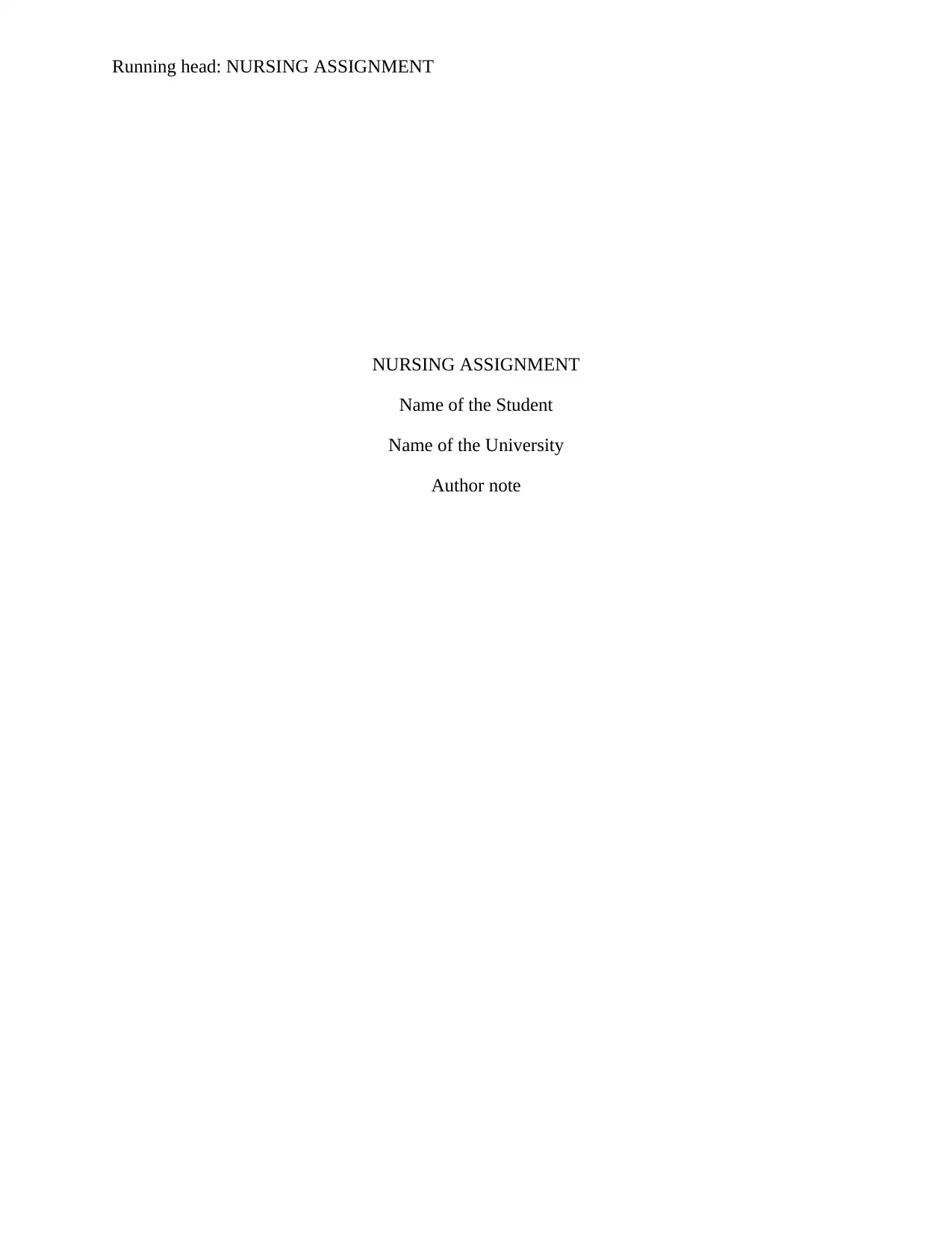
Running head: NURSING ASSIGNMENT
NURSING ASSIGNMENT
Name of the Student
Name of the University
Author note
NURSING ASSIGNMENT
Name of the Student
Name of the University
Author note
Secure Best Marks with AI Grader
Need help grading? Try our AI Grader for instant feedback on your assignments.
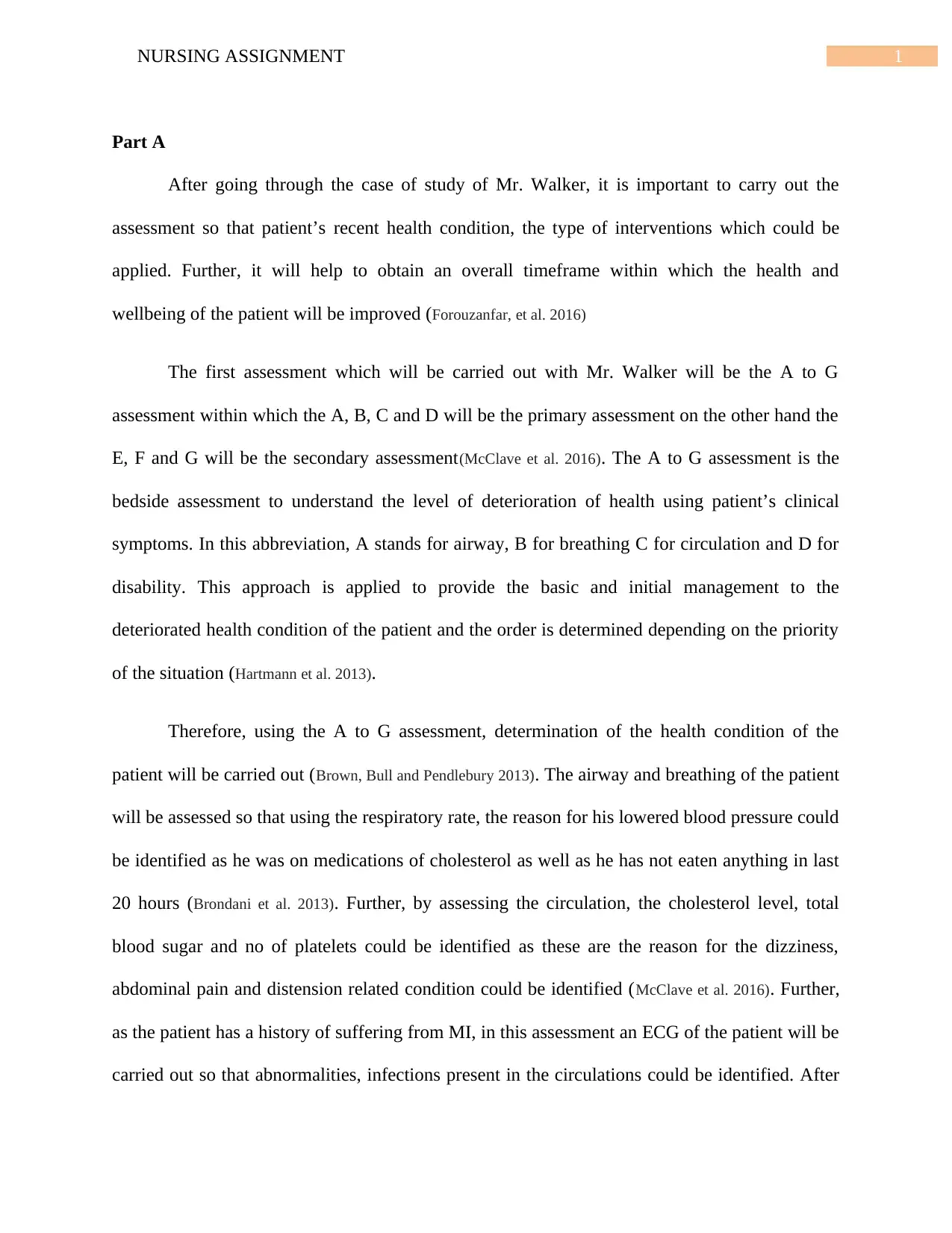
1NURSING ASSIGNMENT
Part A
After going through the case of study of Mr. Walker, it is important to carry out the
assessment so that patient’s recent health condition, the type of interventions which could be
applied. Further, it will help to obtain an overall timeframe within which the health and
wellbeing of the patient will be improved (Forouzanfar, et al. 2016)
The first assessment which will be carried out with Mr. Walker will be the A to G
assessment within which the A, B, C and D will be the primary assessment on the other hand the
E, F and G will be the secondary assessment(McClave et al. 2016). The A to G assessment is the
bedside assessment to understand the level of deterioration of health using patient’s clinical
symptoms. In this abbreviation, A stands for airway, B for breathing C for circulation and D for
disability. This approach is applied to provide the basic and initial management to the
deteriorated health condition of the patient and the order is determined depending on the priority
of the situation (Hartmann et al. 2013).
Therefore, using the A to G assessment, determination of the health condition of the
patient will be carried out (Brown, Bull and Pendlebury 2013). The airway and breathing of the patient
will be assessed so that using the respiratory rate, the reason for his lowered blood pressure could
be identified as he was on medications of cholesterol as well as he has not eaten anything in last
20 hours (Brondani et al. 2013). Further, by assessing the circulation, the cholesterol level, total
blood sugar and no of platelets could be identified as these are the reason for the dizziness,
abdominal pain and distension related condition could be identified (McClave et al. 2016). Further,
as the patient has a history of suffering from MI, in this assessment an ECG of the patient will be
carried out so that abnormalities, infections present in the circulations could be identified. After
Part A
After going through the case of study of Mr. Walker, it is important to carry out the
assessment so that patient’s recent health condition, the type of interventions which could be
applied. Further, it will help to obtain an overall timeframe within which the health and
wellbeing of the patient will be improved (Forouzanfar, et al. 2016)
The first assessment which will be carried out with Mr. Walker will be the A to G
assessment within which the A, B, C and D will be the primary assessment on the other hand the
E, F and G will be the secondary assessment(McClave et al. 2016). The A to G assessment is the
bedside assessment to understand the level of deterioration of health using patient’s clinical
symptoms. In this abbreviation, A stands for airway, B for breathing C for circulation and D for
disability. This approach is applied to provide the basic and initial management to the
deteriorated health condition of the patient and the order is determined depending on the priority
of the situation (Hartmann et al. 2013).
Therefore, using the A to G assessment, determination of the health condition of the
patient will be carried out (Brown, Bull and Pendlebury 2013). The airway and breathing of the patient
will be assessed so that using the respiratory rate, the reason for his lowered blood pressure could
be identified as he was on medications of cholesterol as well as he has not eaten anything in last
20 hours (Brondani et al. 2013). Further, by assessing the circulation, the cholesterol level, total
blood sugar and no of platelets could be identified as these are the reason for the dizziness,
abdominal pain and distension related condition could be identified (McClave et al. 2016). Further,
as the patient has a history of suffering from MI, in this assessment an ECG of the patient will be
carried out so that abnormalities, infections present in the circulations could be identified. After
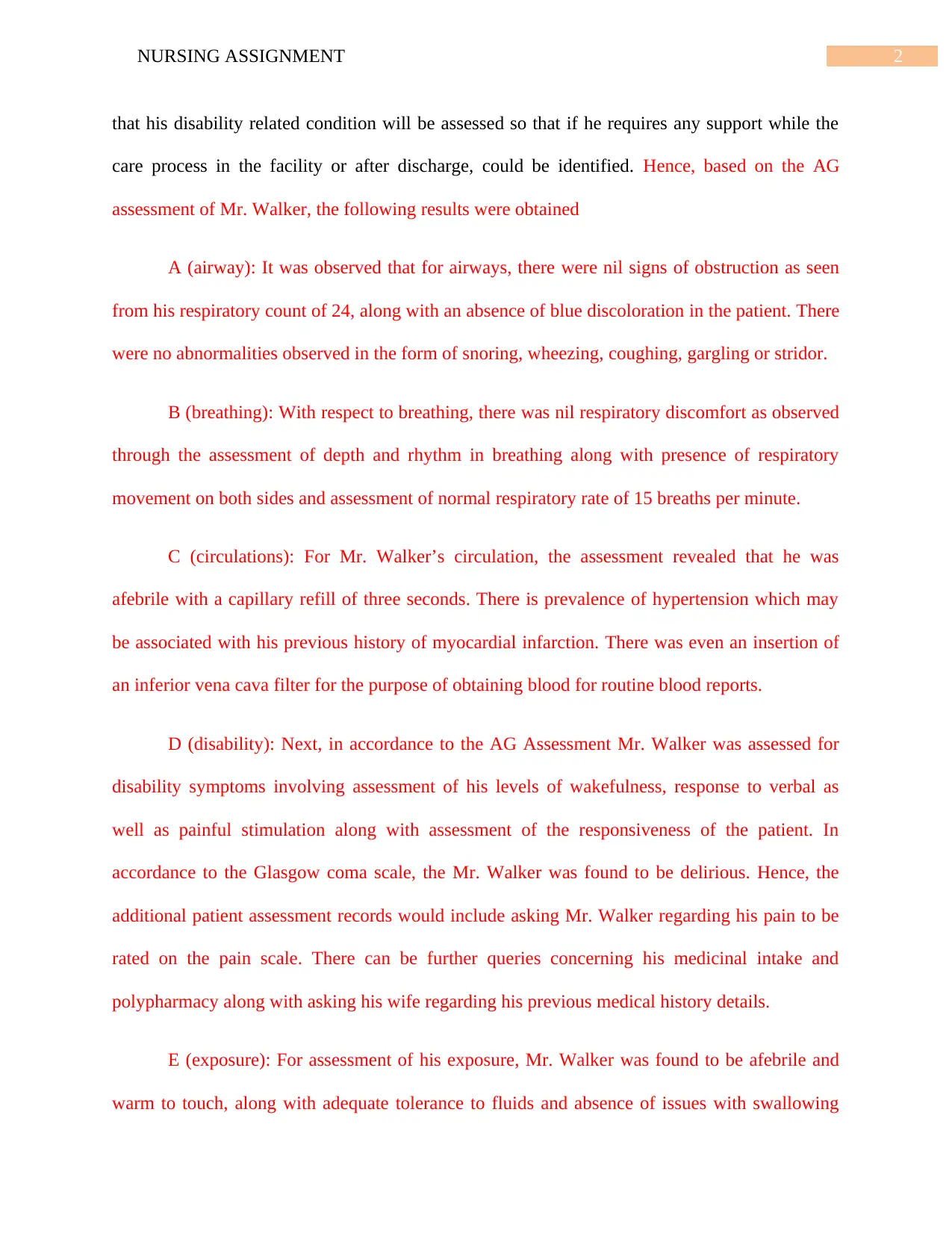
2NURSING ASSIGNMENT
that his disability related condition will be assessed so that if he requires any support while the
care process in the facility or after discharge, could be identified. Hence, based on the AG
assessment of Mr. Walker, the following results were obtained
A (airway): It was observed that for airways, there were nil signs of obstruction as seen
from his respiratory count of 24, along with an absence of blue discoloration in the patient. There
were no abnormalities observed in the form of snoring, wheezing, coughing, gargling or stridor.
B (breathing): With respect to breathing, there was nil respiratory discomfort as observed
through the assessment of depth and rhythm in breathing along with presence of respiratory
movement on both sides and assessment of normal respiratory rate of 15 breaths per minute.
C (circulations): For Mr. Walker’s circulation, the assessment revealed that he was
afebrile with a capillary refill of three seconds. There is prevalence of hypertension which may
be associated with his previous history of myocardial infarction. There was even an insertion of
an inferior vena cava filter for the purpose of obtaining blood for routine blood reports.
D (disability): Next, in accordance to the AG Assessment Mr. Walker was assessed for
disability symptoms involving assessment of his levels of wakefulness, response to verbal as
well as painful stimulation along with assessment of the responsiveness of the patient. In
accordance to the Glasgow coma scale, the Mr. Walker was found to be delirious. Hence, the
additional patient assessment records would include asking Mr. Walker regarding his pain to be
rated on the pain scale. There can be further queries concerning his medicinal intake and
polypharmacy along with asking his wife regarding his previous medical history details.
E (exposure): For assessment of his exposure, Mr. Walker was found to be afebrile and
warm to touch, along with adequate tolerance to fluids and absence of issues with swallowing
that his disability related condition will be assessed so that if he requires any support while the
care process in the facility or after discharge, could be identified. Hence, based on the AG
assessment of Mr. Walker, the following results were obtained
A (airway): It was observed that for airways, there were nil signs of obstruction as seen
from his respiratory count of 24, along with an absence of blue discoloration in the patient. There
were no abnormalities observed in the form of snoring, wheezing, coughing, gargling or stridor.
B (breathing): With respect to breathing, there was nil respiratory discomfort as observed
through the assessment of depth and rhythm in breathing along with presence of respiratory
movement on both sides and assessment of normal respiratory rate of 15 breaths per minute.
C (circulations): For Mr. Walker’s circulation, the assessment revealed that he was
afebrile with a capillary refill of three seconds. There is prevalence of hypertension which may
be associated with his previous history of myocardial infarction. There was even an insertion of
an inferior vena cava filter for the purpose of obtaining blood for routine blood reports.
D (disability): Next, in accordance to the AG Assessment Mr. Walker was assessed for
disability symptoms involving assessment of his levels of wakefulness, response to verbal as
well as painful stimulation along with assessment of the responsiveness of the patient. In
accordance to the Glasgow coma scale, the Mr. Walker was found to be delirious. Hence, the
additional patient assessment records would include asking Mr. Walker regarding his pain to be
rated on the pain scale. There can be further queries concerning his medicinal intake and
polypharmacy along with asking his wife regarding his previous medical history details.
E (exposure): For assessment of his exposure, Mr. Walker was found to be afebrile and
warm to touch, along with adequate tolerance to fluids and absence of issues with swallowing
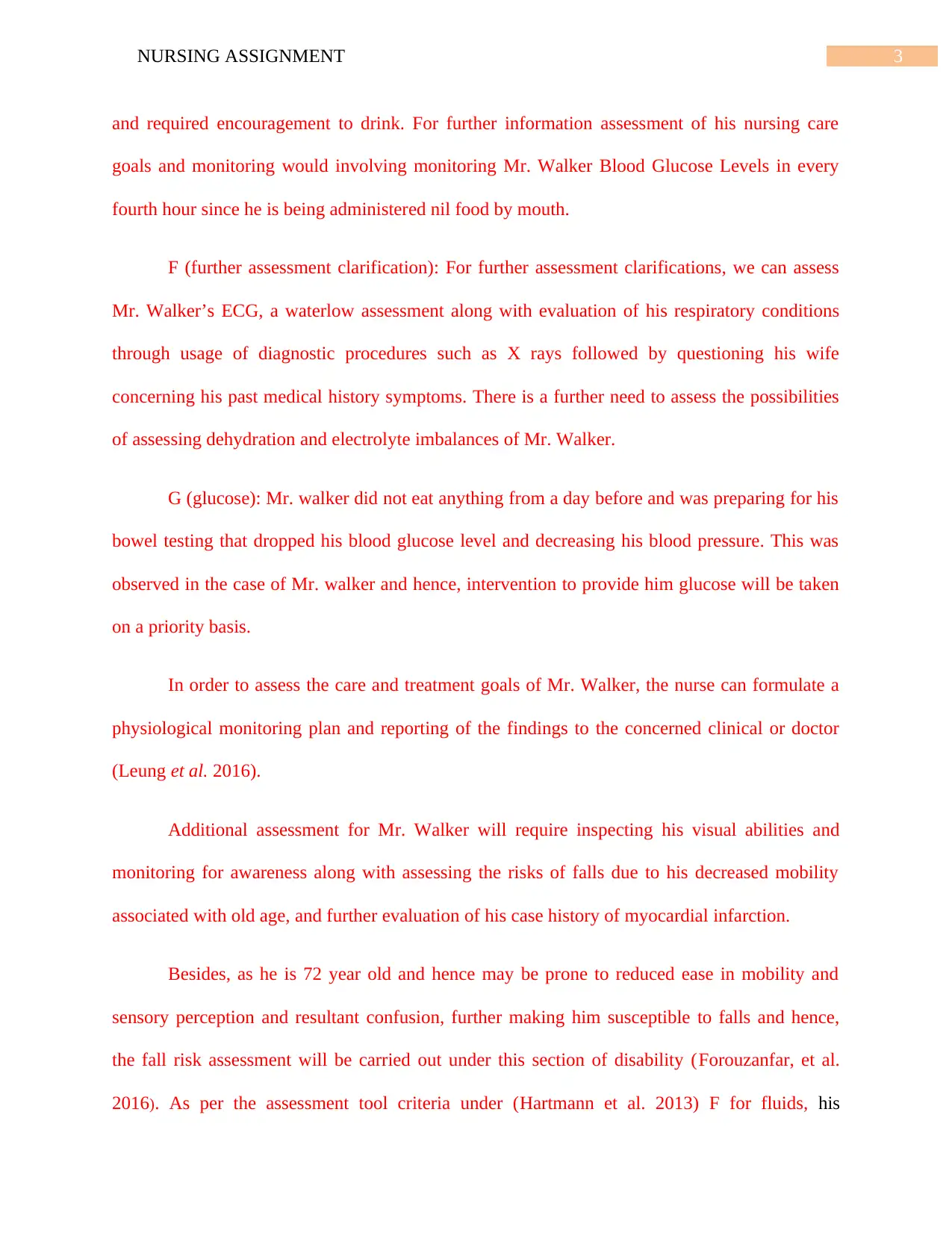
3NURSING ASSIGNMENT
and required encouragement to drink. For further information assessment of his nursing care
goals and monitoring would involving monitoring Mr. Walker Blood Glucose Levels in every
fourth hour since he is being administered nil food by mouth.
F (further assessment clarification): For further assessment clarifications, we can assess
Mr. Walker’s ECG, a waterlow assessment along with evaluation of his respiratory conditions
through usage of diagnostic procedures such as X rays followed by questioning his wife
concerning his past medical history symptoms. There is a further need to assess the possibilities
of assessing dehydration and electrolyte imbalances of Mr. Walker.
G (glucose): Mr. walker did not eat anything from a day before and was preparing for his
bowel testing that dropped his blood glucose level and decreasing his blood pressure. This was
observed in the case of Mr. walker and hence, intervention to provide him glucose will be taken
on a priority basis.
In order to assess the care and treatment goals of Mr. Walker, the nurse can formulate a
physiological monitoring plan and reporting of the findings to the concerned clinical or doctor
(Leung et al. 2016).
Additional assessment for Mr. Walker will require inspecting his visual abilities and
monitoring for awareness along with assessing the risks of falls due to his decreased mobility
associated with old age, and further evaluation of his case history of myocardial infarction.
Besides, as he is 72 year old and hence may be prone to reduced ease in mobility and
sensory perception and resultant confusion, further making him susceptible to falls and hence,
the fall risk assessment will be carried out under this section of disability (Forouzanfar, et al.
2016). As per the assessment tool criteria under (Hartmann et al. 2013) F for fluids, his
and required encouragement to drink. For further information assessment of his nursing care
goals and monitoring would involving monitoring Mr. Walker Blood Glucose Levels in every
fourth hour since he is being administered nil food by mouth.
F (further assessment clarification): For further assessment clarifications, we can assess
Mr. Walker’s ECG, a waterlow assessment along with evaluation of his respiratory conditions
through usage of diagnostic procedures such as X rays followed by questioning his wife
concerning his past medical history symptoms. There is a further need to assess the possibilities
of assessing dehydration and electrolyte imbalances of Mr. Walker.
G (glucose): Mr. walker did not eat anything from a day before and was preparing for his
bowel testing that dropped his blood glucose level and decreasing his blood pressure. This was
observed in the case of Mr. walker and hence, intervention to provide him glucose will be taken
on a priority basis.
In order to assess the care and treatment goals of Mr. Walker, the nurse can formulate a
physiological monitoring plan and reporting of the findings to the concerned clinical or doctor
(Leung et al. 2016).
Additional assessment for Mr. Walker will require inspecting his visual abilities and
monitoring for awareness along with assessing the risks of falls due to his decreased mobility
associated with old age, and further evaluation of his case history of myocardial infarction.
Besides, as he is 72 year old and hence may be prone to reduced ease in mobility and
sensory perception and resultant confusion, further making him susceptible to falls and hence,
the fall risk assessment will be carried out under this section of disability (Forouzanfar, et al.
2016). As per the assessment tool criteria under (Hartmann et al. 2013) F for fluids, his
Secure Best Marks with AI Grader
Need help grading? Try our AI Grader for instant feedback on your assignments.

4NURSING ASSIGNMENT
respiratory rate, blood pressure, body temperature, blood sugar level SpO2 and RA will be
obtained so that complete analysis could be achieved. All these assessments mentioned in the
above section will be done by the healthcare professionals keeping in mind the age of the patient.
As he is 72 year old, he is prone to falls, he may suffer from visual impairment and as per his
wife he takes medicine for blood pressure control. Therefore, in this assessment section, usage of
A to G assessment tool, fall risk assessment tool, patient’s visual impairment assessment tool,
and his pain related Glasgow pain scale assessment tools were chosen so that while determining
the patient condition, these could be used as a mean to provide care to the patient (Forouzanfar,
et al. 2016).
Part B
After 3 hours of the completion of the assessment it was seen that the patient condition
starts deteriorating within the emergency ward and Mr. Walker is suffering from severe chest
pain. The patient was previously diagnosed as diaphoretic and tachycardic symptoms in the A to
G assessment and then suddenly his agitation related behavior started increasing. Due to this he
became agitated and then called out for help to get out of his help. Therefore, in this situation,
my primary role will be relieving the patient condition.
How the chest pain was reduced
Further, in accordance to the medical condition of Mr. Walker, the need of the hour is to
activate the NSW Chest pain Protocol, for which a multidisciplinary approach involving a
cardiologist will be utilized. Hence, prior to management of agitation, there will be conductance
of echocardiogram along with analysis of the acquired chest ray reports of Mr. Walker. The
respiratory rate, blood pressure, body temperature, blood sugar level SpO2 and RA will be
obtained so that complete analysis could be achieved. All these assessments mentioned in the
above section will be done by the healthcare professionals keeping in mind the age of the patient.
As he is 72 year old, he is prone to falls, he may suffer from visual impairment and as per his
wife he takes medicine for blood pressure control. Therefore, in this assessment section, usage of
A to G assessment tool, fall risk assessment tool, patient’s visual impairment assessment tool,
and his pain related Glasgow pain scale assessment tools were chosen so that while determining
the patient condition, these could be used as a mean to provide care to the patient (Forouzanfar,
et al. 2016).
Part B
After 3 hours of the completion of the assessment it was seen that the patient condition
starts deteriorating within the emergency ward and Mr. Walker is suffering from severe chest
pain. The patient was previously diagnosed as diaphoretic and tachycardic symptoms in the A to
G assessment and then suddenly his agitation related behavior started increasing. Due to this he
became agitated and then called out for help to get out of his help. Therefore, in this situation,
my primary role will be relieving the patient condition.
How the chest pain was reduced
Further, in accordance to the medical condition of Mr. Walker, the need of the hour is to
activate the NSW Chest pain Protocol, for which a multidisciplinary approach involving a
cardiologist will be utilized. Hence, prior to management of agitation, there will be conductance
of echocardiogram along with analysis of the acquired chest ray reports of Mr. Walker. The
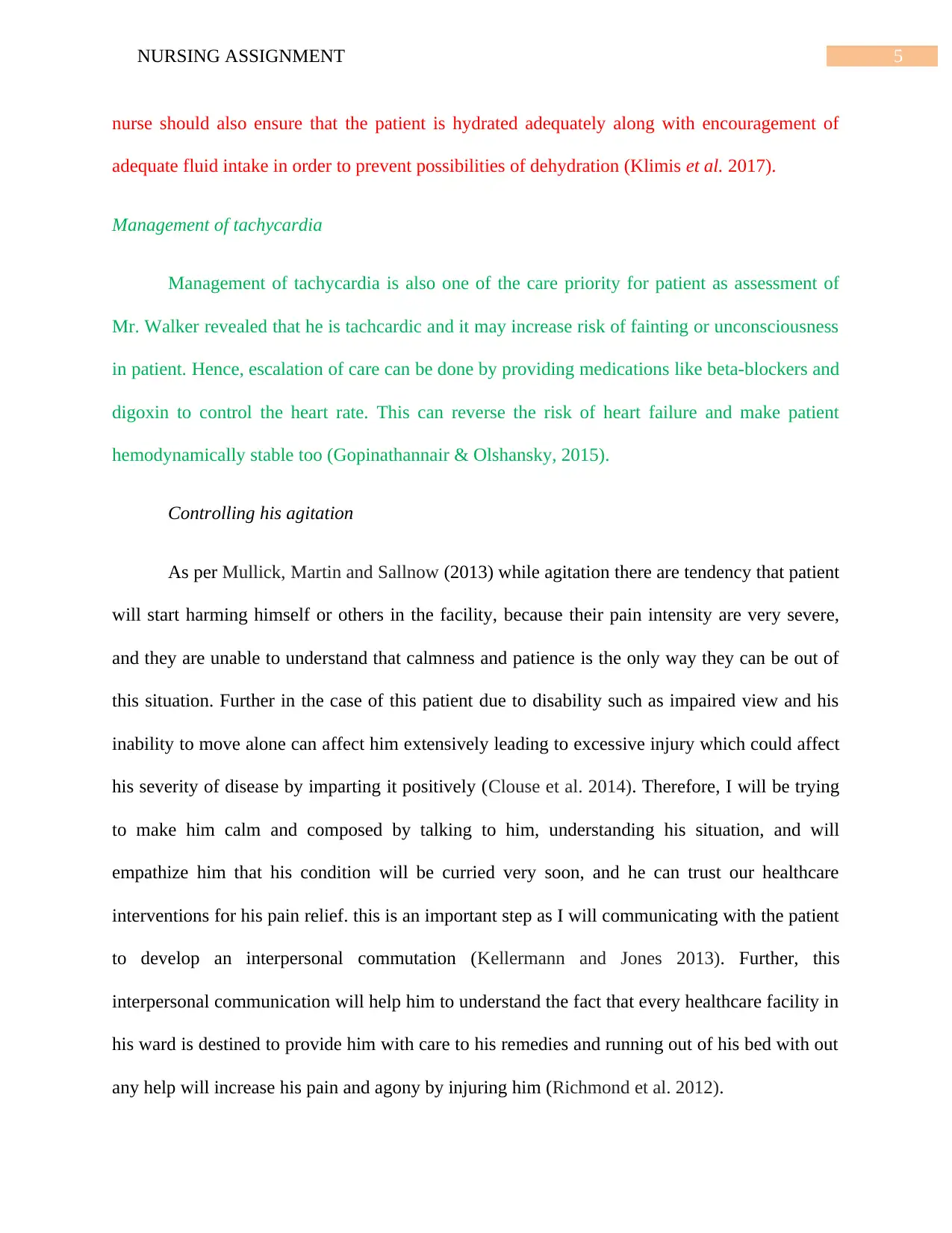
5NURSING ASSIGNMENT
nurse should also ensure that the patient is hydrated adequately along with encouragement of
adequate fluid intake in order to prevent possibilities of dehydration (Klimis et al. 2017).
Management of tachycardia
Management of tachycardia is also one of the care priority for patient as assessment of
Mr. Walker revealed that he is tachcardic and it may increase risk of fainting or unconsciousness
in patient. Hence, escalation of care can be done by providing medications like beta-blockers and
digoxin to control the heart rate. This can reverse the risk of heart failure and make patient
hemodynamically stable too (Gopinathannair & Olshansky, 2015).
Controlling his agitation
As per Mullick, Martin and Sallnow (2013) while agitation there are tendency that patient
will start harming himself or others in the facility, because their pain intensity are very severe,
and they are unable to understand that calmness and patience is the only way they can be out of
this situation. Further in the case of this patient due to disability such as impaired view and his
inability to move alone can affect him extensively leading to excessive injury which could affect
his severity of disease by imparting it positively (Clouse et al. 2014). Therefore, I will be trying
to make him calm and composed by talking to him, understanding his situation, and will
empathize him that his condition will be curried very soon, and he can trust our healthcare
interventions for his pain relief. this is an important step as I will communicating with the patient
to develop an interpersonal commutation (Kellermann and Jones 2013). Further, this
interpersonal communication will help him to understand the fact that every healthcare facility in
his ward is destined to provide him with care to his remedies and running out of his bed with out
any help will increase his pain and agony by injuring him (Richmond et al. 2012).
nurse should also ensure that the patient is hydrated adequately along with encouragement of
adequate fluid intake in order to prevent possibilities of dehydration (Klimis et al. 2017).
Management of tachycardia
Management of tachycardia is also one of the care priority for patient as assessment of
Mr. Walker revealed that he is tachcardic and it may increase risk of fainting or unconsciousness
in patient. Hence, escalation of care can be done by providing medications like beta-blockers and
digoxin to control the heart rate. This can reverse the risk of heart failure and make patient
hemodynamically stable too (Gopinathannair & Olshansky, 2015).
Controlling his agitation
As per Mullick, Martin and Sallnow (2013) while agitation there are tendency that patient
will start harming himself or others in the facility, because their pain intensity are very severe,
and they are unable to understand that calmness and patience is the only way they can be out of
this situation. Further in the case of this patient due to disability such as impaired view and his
inability to move alone can affect him extensively leading to excessive injury which could affect
his severity of disease by imparting it positively (Clouse et al. 2014). Therefore, I will be trying
to make him calm and composed by talking to him, understanding his situation, and will
empathize him that his condition will be curried very soon, and he can trust our healthcare
interventions for his pain relief. this is an important step as I will communicating with the patient
to develop an interpersonal commutation (Kellermann and Jones 2013). Further, this
interpersonal communication will help him to understand the fact that every healthcare facility in
his ward is destined to provide him with care to his remedies and running out of his bed with out
any help will increase his pain and agony by injuring him (Richmond et al. 2012).
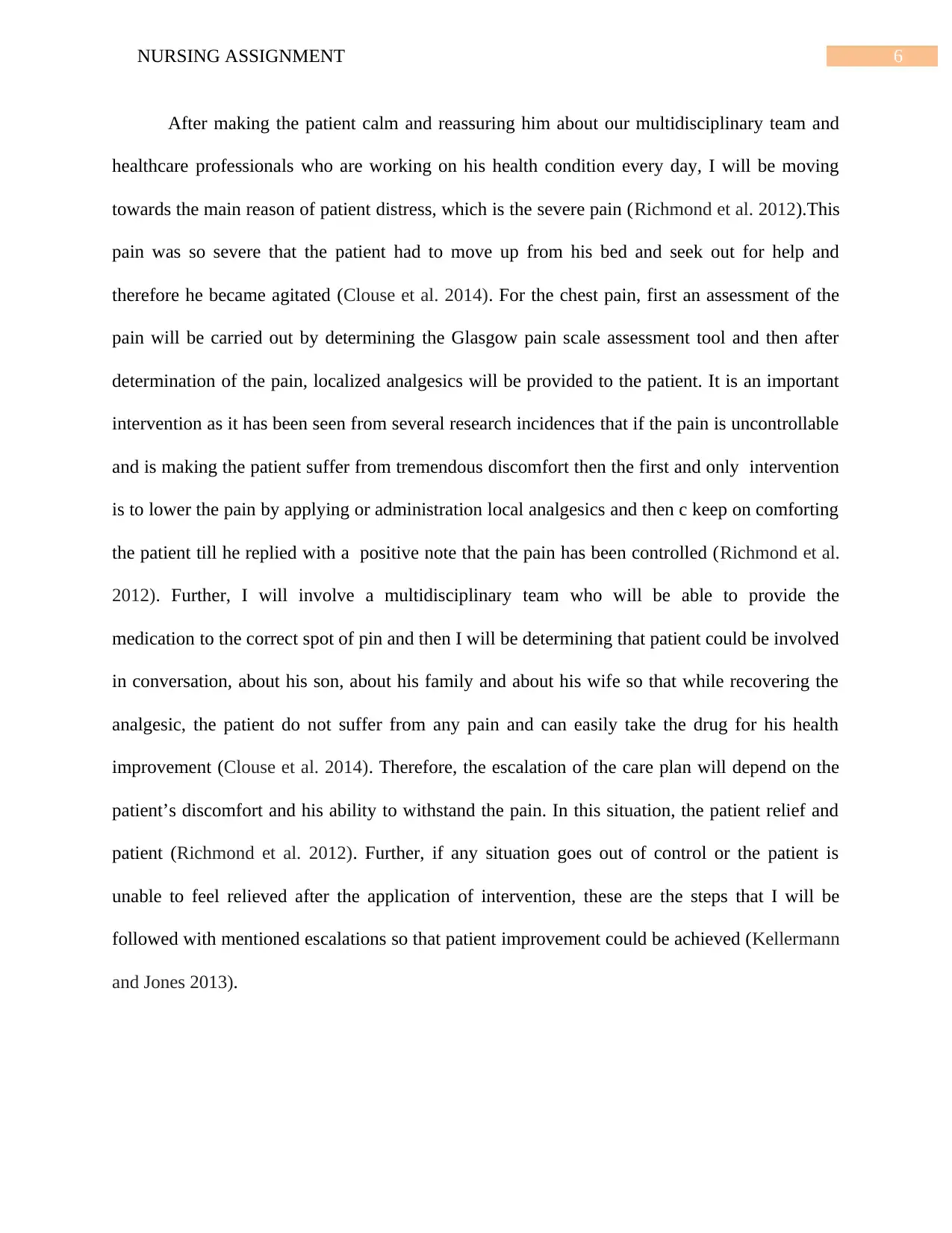
6NURSING ASSIGNMENT
After making the patient calm and reassuring him about our multidisciplinary team and
healthcare professionals who are working on his health condition every day, I will be moving
towards the main reason of patient distress, which is the severe pain (Richmond et al. 2012).This
pain was so severe that the patient had to move up from his bed and seek out for help and
therefore he became agitated (Clouse et al. 2014). For the chest pain, first an assessment of the
pain will be carried out by determining the Glasgow pain scale assessment tool and then after
determination of the pain, localized analgesics will be provided to the patient. It is an important
intervention as it has been seen from several research incidences that if the pain is uncontrollable
and is making the patient suffer from tremendous discomfort then the first and only intervention
is to lower the pain by applying or administration local analgesics and then c keep on comforting
the patient till he replied with a positive note that the pain has been controlled (Richmond et al.
2012). Further, I will involve a multidisciplinary team who will be able to provide the
medication to the correct spot of pin and then I will be determining that patient could be involved
in conversation, about his son, about his family and about his wife so that while recovering the
analgesic, the patient do not suffer from any pain and can easily take the drug for his health
improvement (Clouse et al. 2014). Therefore, the escalation of the care plan will depend on the
patient’s discomfort and his ability to withstand the pain. In this situation, the patient relief and
patient (Richmond et al. 2012). Further, if any situation goes out of control or the patient is
unable to feel relieved after the application of intervention, these are the steps that I will be
followed with mentioned escalations so that patient improvement could be achieved (Kellermann
and Jones 2013).
After making the patient calm and reassuring him about our multidisciplinary team and
healthcare professionals who are working on his health condition every day, I will be moving
towards the main reason of patient distress, which is the severe pain (Richmond et al. 2012).This
pain was so severe that the patient had to move up from his bed and seek out for help and
therefore he became agitated (Clouse et al. 2014). For the chest pain, first an assessment of the
pain will be carried out by determining the Glasgow pain scale assessment tool and then after
determination of the pain, localized analgesics will be provided to the patient. It is an important
intervention as it has been seen from several research incidences that if the pain is uncontrollable
and is making the patient suffer from tremendous discomfort then the first and only intervention
is to lower the pain by applying or administration local analgesics and then c keep on comforting
the patient till he replied with a positive note that the pain has been controlled (Richmond et al.
2012). Further, I will involve a multidisciplinary team who will be able to provide the
medication to the correct spot of pin and then I will be determining that patient could be involved
in conversation, about his son, about his family and about his wife so that while recovering the
analgesic, the patient do not suffer from any pain and can easily take the drug for his health
improvement (Clouse et al. 2014). Therefore, the escalation of the care plan will depend on the
patient’s discomfort and his ability to withstand the pain. In this situation, the patient relief and
patient (Richmond et al. 2012). Further, if any situation goes out of control or the patient is
unable to feel relieved after the application of intervention, these are the steps that I will be
followed with mentioned escalations so that patient improvement could be achieved (Kellermann
and Jones 2013).
Paraphrase This Document
Need a fresh take? Get an instant paraphrase of this document with our AI Paraphraser
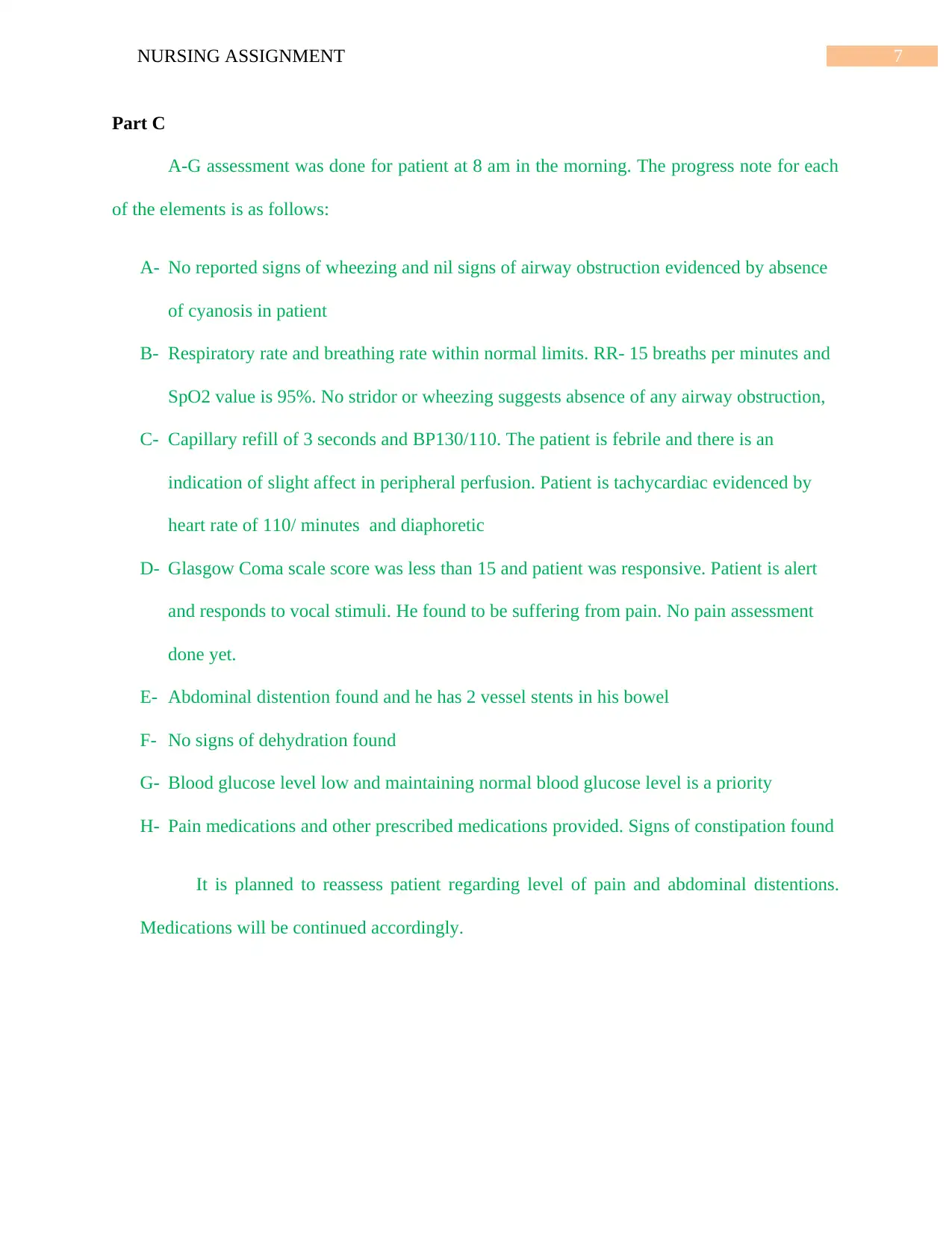
7NURSING ASSIGNMENT
Part C
A-G assessment was done for patient at 8 am in the morning. The progress note for each
of the elements is as follows:
A- No reported signs of wheezing and nil signs of airway obstruction evidenced by absence
of cyanosis in patient
B- Respiratory rate and breathing rate within normal limits. RR- 15 breaths per minutes and
SpO2 value is 95%. No stridor or wheezing suggests absence of any airway obstruction,
C- Capillary refill of 3 seconds and BP130/110. The patient is febrile and there is an
indication of slight affect in peripheral perfusion. Patient is tachycardiac evidenced by
heart rate of 110/ minutes and diaphoretic
D- Glasgow Coma scale score was less than 15 and patient was responsive. Patient is alert
and responds to vocal stimuli. He found to be suffering from pain. No pain assessment
done yet.
E- Abdominal distention found and he has 2 vessel stents in his bowel
F- No signs of dehydration found
G- Blood glucose level low and maintaining normal blood glucose level is a priority
H- Pain medications and other prescribed medications provided. Signs of constipation found
It is planned to reassess patient regarding level of pain and abdominal distentions.
Medications will be continued accordingly.
Part C
A-G assessment was done for patient at 8 am in the morning. The progress note for each
of the elements is as follows:
A- No reported signs of wheezing and nil signs of airway obstruction evidenced by absence
of cyanosis in patient
B- Respiratory rate and breathing rate within normal limits. RR- 15 breaths per minutes and
SpO2 value is 95%. No stridor or wheezing suggests absence of any airway obstruction,
C- Capillary refill of 3 seconds and BP130/110. The patient is febrile and there is an
indication of slight affect in peripheral perfusion. Patient is tachycardiac evidenced by
heart rate of 110/ minutes and diaphoretic
D- Glasgow Coma scale score was less than 15 and patient was responsive. Patient is alert
and responds to vocal stimuli. He found to be suffering from pain. No pain assessment
done yet.
E- Abdominal distention found and he has 2 vessel stents in his bowel
F- No signs of dehydration found
G- Blood glucose level low and maintaining normal blood glucose level is a priority
H- Pain medications and other prescribed medications provided. Signs of constipation found
It is planned to reassess patient regarding level of pain and abdominal distentions.
Medications will be continued accordingly.
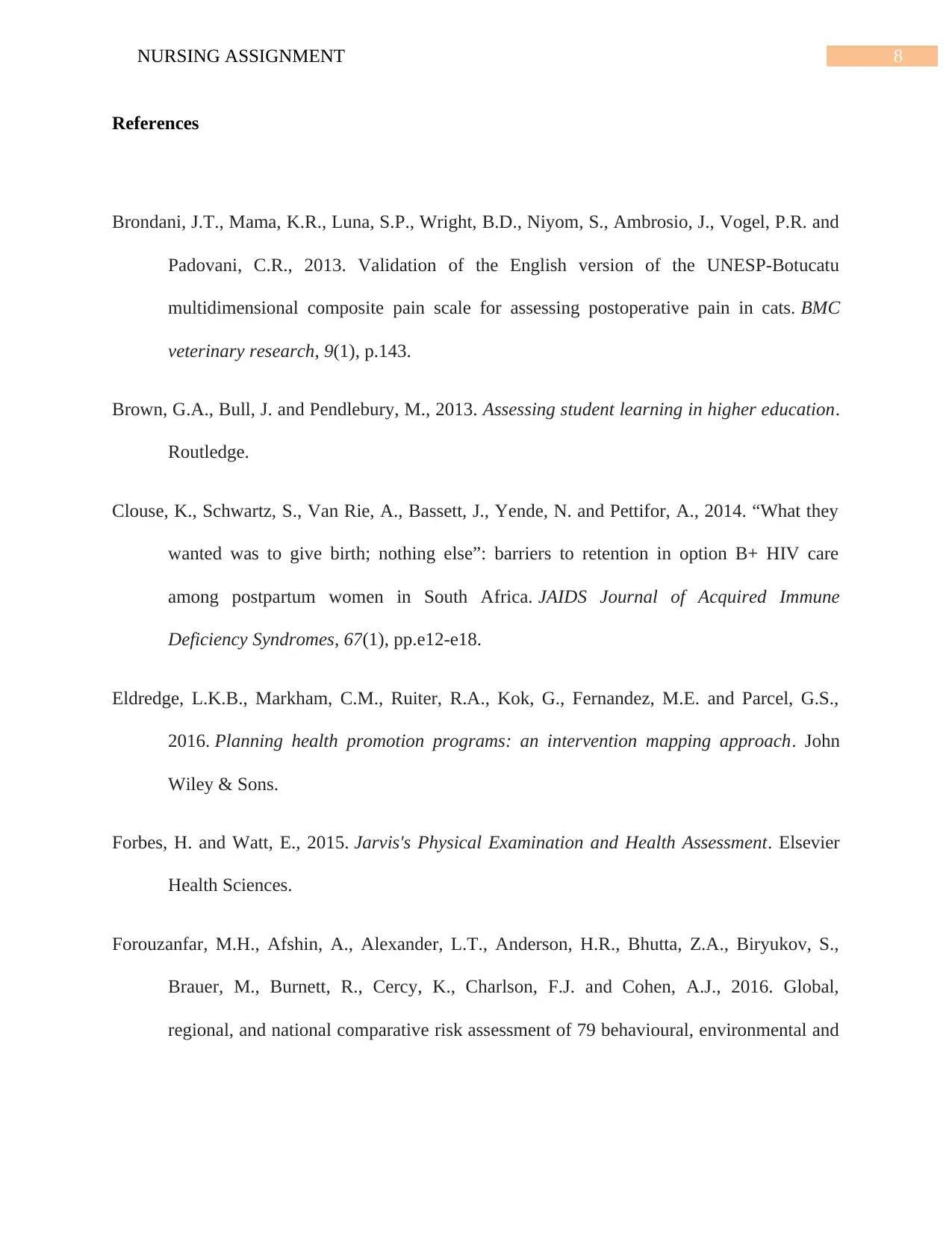
8NURSING ASSIGNMENT
References
Brondani, J.T., Mama, K.R., Luna, S.P., Wright, B.D., Niyom, S., Ambrosio, J., Vogel, P.R. and
Padovani, C.R., 2013. Validation of the English version of the UNESP-Botucatu
multidimensional composite pain scale for assessing postoperative pain in cats. BMC
veterinary research, 9(1), p.143.
Brown, G.A., Bull, J. and Pendlebury, M., 2013. Assessing student learning in higher education.
Routledge.
Clouse, K., Schwartz, S., Van Rie, A., Bassett, J., Yende, N. and Pettifor, A., 2014. “What they
wanted was to give birth; nothing else”: barriers to retention in option B+ HIV care
among postpartum women in South Africa. JAIDS Journal of Acquired Immune
Deficiency Syndromes, 67(1), pp.e12-e18.
Eldredge, L.K.B., Markham, C.M., Ruiter, R.A., Kok, G., Fernandez, M.E. and Parcel, G.S.,
2016. Planning health promotion programs: an intervention mapping approach. John
Wiley & Sons.
Forbes, H. and Watt, E., 2015. Jarvis's Physical Examination and Health Assessment. Elsevier
Health Sciences.
Forouzanfar, M.H., Afshin, A., Alexander, L.T., Anderson, H.R., Bhutta, Z.A., Biryukov, S.,
Brauer, M., Burnett, R., Cercy, K., Charlson, F.J. and Cohen, A.J., 2016. Global,
regional, and national comparative risk assessment of 79 behavioural, environmental and
References
Brondani, J.T., Mama, K.R., Luna, S.P., Wright, B.D., Niyom, S., Ambrosio, J., Vogel, P.R. and
Padovani, C.R., 2013. Validation of the English version of the UNESP-Botucatu
multidimensional composite pain scale for assessing postoperative pain in cats. BMC
veterinary research, 9(1), p.143.
Brown, G.A., Bull, J. and Pendlebury, M., 2013. Assessing student learning in higher education.
Routledge.
Clouse, K., Schwartz, S., Van Rie, A., Bassett, J., Yende, N. and Pettifor, A., 2014. “What they
wanted was to give birth; nothing else”: barriers to retention in option B+ HIV care
among postpartum women in South Africa. JAIDS Journal of Acquired Immune
Deficiency Syndromes, 67(1), pp.e12-e18.
Eldredge, L.K.B., Markham, C.M., Ruiter, R.A., Kok, G., Fernandez, M.E. and Parcel, G.S.,
2016. Planning health promotion programs: an intervention mapping approach. John
Wiley & Sons.
Forbes, H. and Watt, E., 2015. Jarvis's Physical Examination and Health Assessment. Elsevier
Health Sciences.
Forouzanfar, M.H., Afshin, A., Alexander, L.T., Anderson, H.R., Bhutta, Z.A., Biryukov, S.,
Brauer, M., Burnett, R., Cercy, K., Charlson, F.J. and Cohen, A.J., 2016. Global,
regional, and national comparative risk assessment of 79 behavioural, environmental and
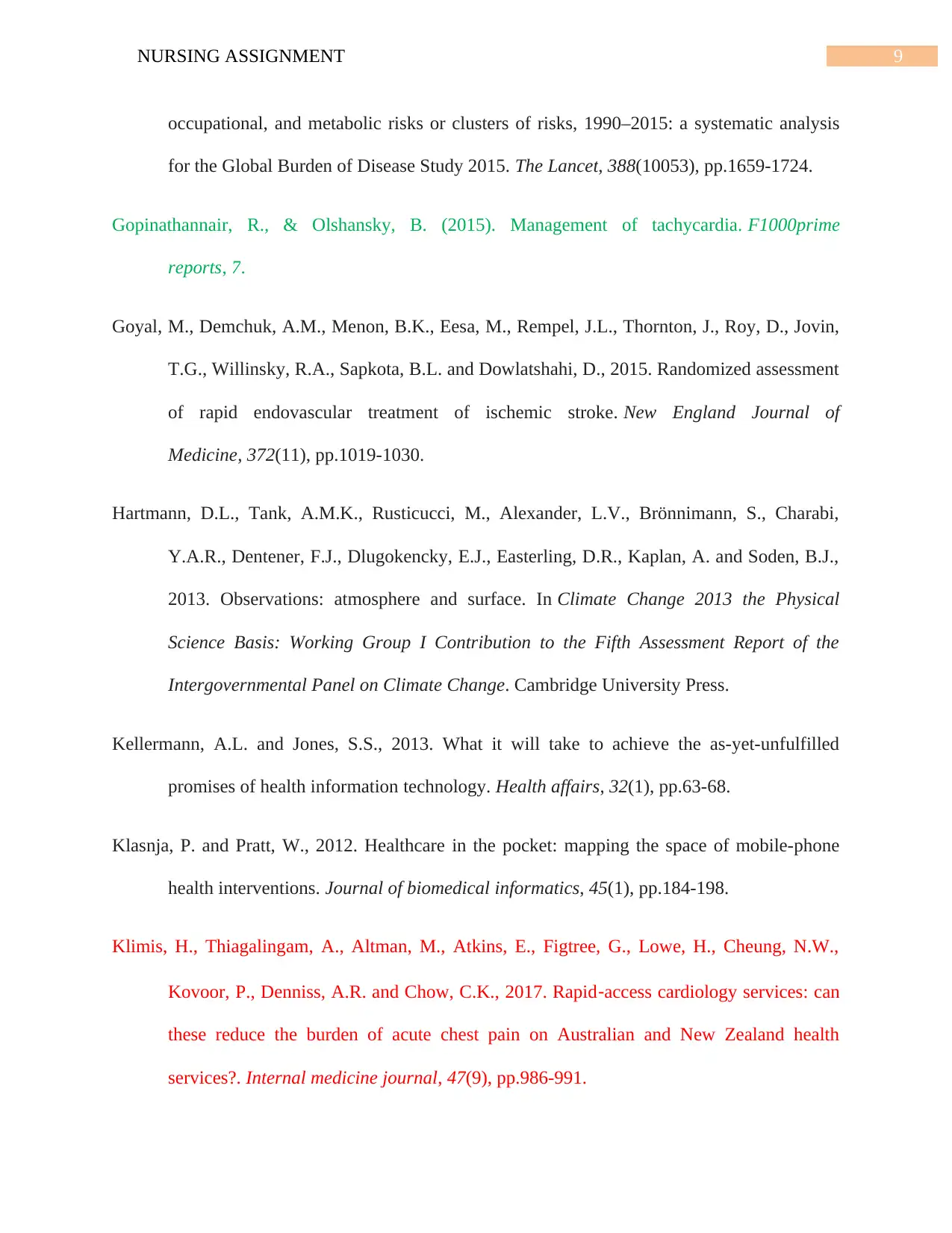
9NURSING ASSIGNMENT
occupational, and metabolic risks or clusters of risks, 1990–2015: a systematic analysis
for the Global Burden of Disease Study 2015. The Lancet, 388(10053), pp.1659-1724.
Gopinathannair, R., & Olshansky, B. (2015). Management of tachycardia. F1000prime
reports, 7.
Goyal, M., Demchuk, A.M., Menon, B.K., Eesa, M., Rempel, J.L., Thornton, J., Roy, D., Jovin,
T.G., Willinsky, R.A., Sapkota, B.L. and Dowlatshahi, D., 2015. Randomized assessment
of rapid endovascular treatment of ischemic stroke. New England Journal of
Medicine, 372(11), pp.1019-1030.
Hartmann, D.L., Tank, A.M.K., Rusticucci, M., Alexander, L.V., Brönnimann, S., Charabi,
Y.A.R., Dentener, F.J., Dlugokencky, E.J., Easterling, D.R., Kaplan, A. and Soden, B.J.,
2013. Observations: atmosphere and surface. In Climate Change 2013 the Physical
Science Basis: Working Group I Contribution to the Fifth Assessment Report of the
Intergovernmental Panel on Climate Change. Cambridge University Press.
Kellermann, A.L. and Jones, S.S., 2013. What it will take to achieve the as-yet-unfulfilled
promises of health information technology. Health affairs, 32(1), pp.63-68.
Klasnja, P. and Pratt, W., 2012. Healthcare in the pocket: mapping the space of mobile-phone
health interventions. Journal of biomedical informatics, 45(1), pp.184-198.
Klimis, H., Thiagalingam, A., Altman, M., Atkins, E., Figtree, G., Lowe, H., Cheung, N.W.,
Kovoor, P., Denniss, A.R. and Chow, C.K., 2017. Rapid‐access cardiology services: can
these reduce the burden of acute chest pain on Australian and New Zealand health
services?. Internal medicine journal, 47(9), pp.986-991.
occupational, and metabolic risks or clusters of risks, 1990–2015: a systematic analysis
for the Global Burden of Disease Study 2015. The Lancet, 388(10053), pp.1659-1724.
Gopinathannair, R., & Olshansky, B. (2015). Management of tachycardia. F1000prime
reports, 7.
Goyal, M., Demchuk, A.M., Menon, B.K., Eesa, M., Rempel, J.L., Thornton, J., Roy, D., Jovin,
T.G., Willinsky, R.A., Sapkota, B.L. and Dowlatshahi, D., 2015. Randomized assessment
of rapid endovascular treatment of ischemic stroke. New England Journal of
Medicine, 372(11), pp.1019-1030.
Hartmann, D.L., Tank, A.M.K., Rusticucci, M., Alexander, L.V., Brönnimann, S., Charabi,
Y.A.R., Dentener, F.J., Dlugokencky, E.J., Easterling, D.R., Kaplan, A. and Soden, B.J.,
2013. Observations: atmosphere and surface. In Climate Change 2013 the Physical
Science Basis: Working Group I Contribution to the Fifth Assessment Report of the
Intergovernmental Panel on Climate Change. Cambridge University Press.
Kellermann, A.L. and Jones, S.S., 2013. What it will take to achieve the as-yet-unfulfilled
promises of health information technology. Health affairs, 32(1), pp.63-68.
Klasnja, P. and Pratt, W., 2012. Healthcare in the pocket: mapping the space of mobile-phone
health interventions. Journal of biomedical informatics, 45(1), pp.184-198.
Klimis, H., Thiagalingam, A., Altman, M., Atkins, E., Figtree, G., Lowe, H., Cheung, N.W.,
Kovoor, P., Denniss, A.R. and Chow, C.K., 2017. Rapid‐access cardiology services: can
these reduce the burden of acute chest pain on Australian and New Zealand health
services?. Internal medicine journal, 47(9), pp.986-991.
Secure Best Marks with AI Grader
Need help grading? Try our AI Grader for instant feedback on your assignments.
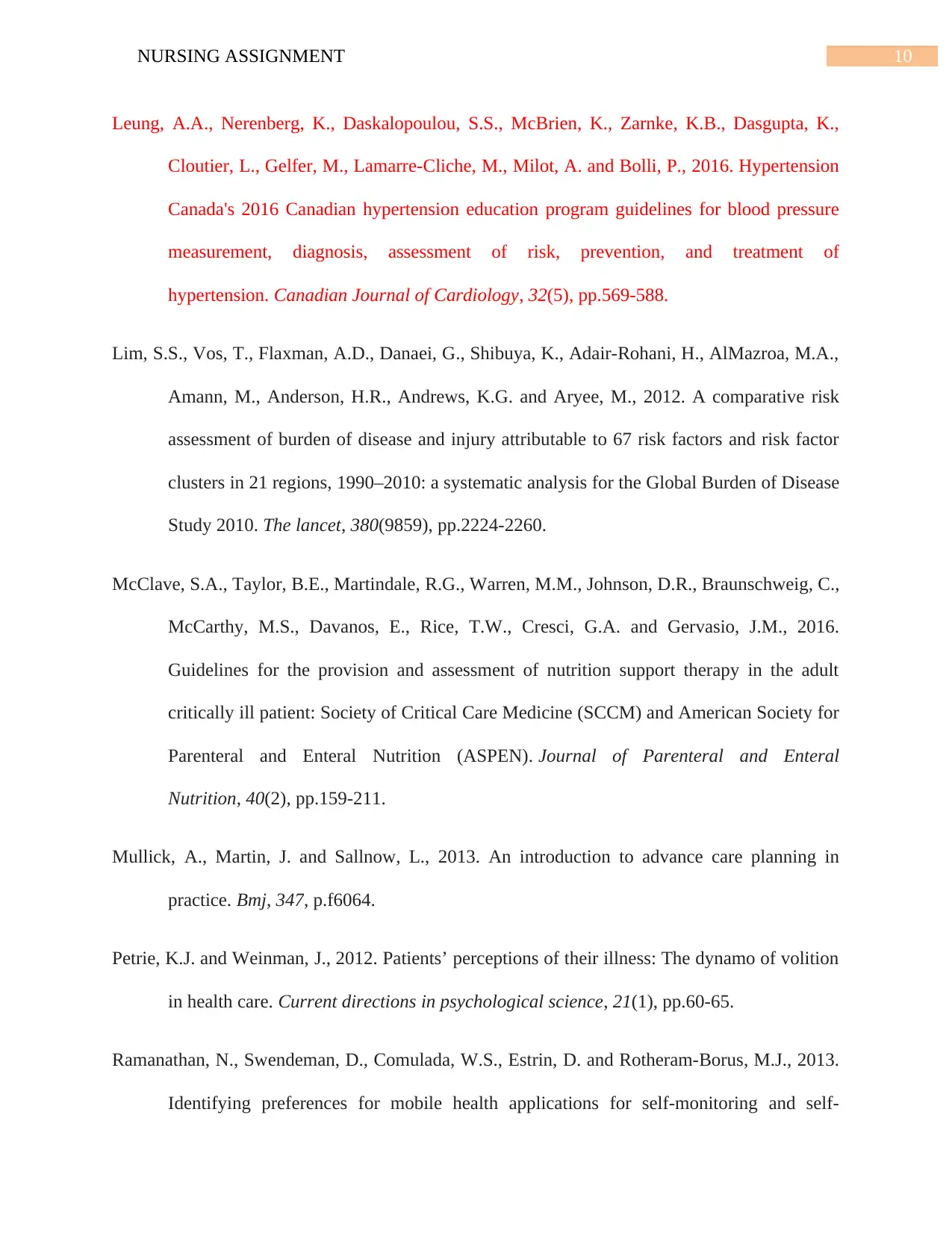
10NURSING ASSIGNMENT
Leung, A.A., Nerenberg, K., Daskalopoulou, S.S., McBrien, K., Zarnke, K.B., Dasgupta, K.,
Cloutier, L., Gelfer, M., Lamarre-Cliche, M., Milot, A. and Bolli, P., 2016. Hypertension
Canada's 2016 Canadian hypertension education program guidelines for blood pressure
measurement, diagnosis, assessment of risk, prevention, and treatment of
hypertension. Canadian Journal of Cardiology, 32(5), pp.569-588.
Lim, S.S., Vos, T., Flaxman, A.D., Danaei, G., Shibuya, K., Adair-Rohani, H., AlMazroa, M.A.,
Amann, M., Anderson, H.R., Andrews, K.G. and Aryee, M., 2012. A comparative risk
assessment of burden of disease and injury attributable to 67 risk factors and risk factor
clusters in 21 regions, 1990–2010: a systematic analysis for the Global Burden of Disease
Study 2010. The lancet, 380(9859), pp.2224-2260.
McClave, S.A., Taylor, B.E., Martindale, R.G., Warren, M.M., Johnson, D.R., Braunschweig, C.,
McCarthy, M.S., Davanos, E., Rice, T.W., Cresci, G.A. and Gervasio, J.M., 2016.
Guidelines for the provision and assessment of nutrition support therapy in the adult
critically ill patient: Society of Critical Care Medicine (SCCM) and American Society for
Parenteral and Enteral Nutrition (ASPEN). Journal of Parenteral and Enteral
Nutrition, 40(2), pp.159-211.
Mullick, A., Martin, J. and Sallnow, L., 2013. An introduction to advance care planning in
practice. Bmj, 347, p.f6064.
Petrie, K.J. and Weinman, J., 2012. Patients’ perceptions of their illness: The dynamo of volition
in health care. Current directions in psychological science, 21(1), pp.60-65.
Ramanathan, N., Swendeman, D., Comulada, W.S., Estrin, D. and Rotheram-Borus, M.J., 2013.
Identifying preferences for mobile health applications for self-monitoring and self-
Leung, A.A., Nerenberg, K., Daskalopoulou, S.S., McBrien, K., Zarnke, K.B., Dasgupta, K.,
Cloutier, L., Gelfer, M., Lamarre-Cliche, M., Milot, A. and Bolli, P., 2016. Hypertension
Canada's 2016 Canadian hypertension education program guidelines for blood pressure
measurement, diagnosis, assessment of risk, prevention, and treatment of
hypertension. Canadian Journal of Cardiology, 32(5), pp.569-588.
Lim, S.S., Vos, T., Flaxman, A.D., Danaei, G., Shibuya, K., Adair-Rohani, H., AlMazroa, M.A.,
Amann, M., Anderson, H.R., Andrews, K.G. and Aryee, M., 2012. A comparative risk
assessment of burden of disease and injury attributable to 67 risk factors and risk factor
clusters in 21 regions, 1990–2010: a systematic analysis for the Global Burden of Disease
Study 2010. The lancet, 380(9859), pp.2224-2260.
McClave, S.A., Taylor, B.E., Martindale, R.G., Warren, M.M., Johnson, D.R., Braunschweig, C.,
McCarthy, M.S., Davanos, E., Rice, T.W., Cresci, G.A. and Gervasio, J.M., 2016.
Guidelines for the provision and assessment of nutrition support therapy in the adult
critically ill patient: Society of Critical Care Medicine (SCCM) and American Society for
Parenteral and Enteral Nutrition (ASPEN). Journal of Parenteral and Enteral
Nutrition, 40(2), pp.159-211.
Mullick, A., Martin, J. and Sallnow, L., 2013. An introduction to advance care planning in
practice. Bmj, 347, p.f6064.
Petrie, K.J. and Weinman, J., 2012. Patients’ perceptions of their illness: The dynamo of volition
in health care. Current directions in psychological science, 21(1), pp.60-65.
Ramanathan, N., Swendeman, D., Comulada, W.S., Estrin, D. and Rotheram-Borus, M.J., 2013.
Identifying preferences for mobile health applications for self-monitoring and self-
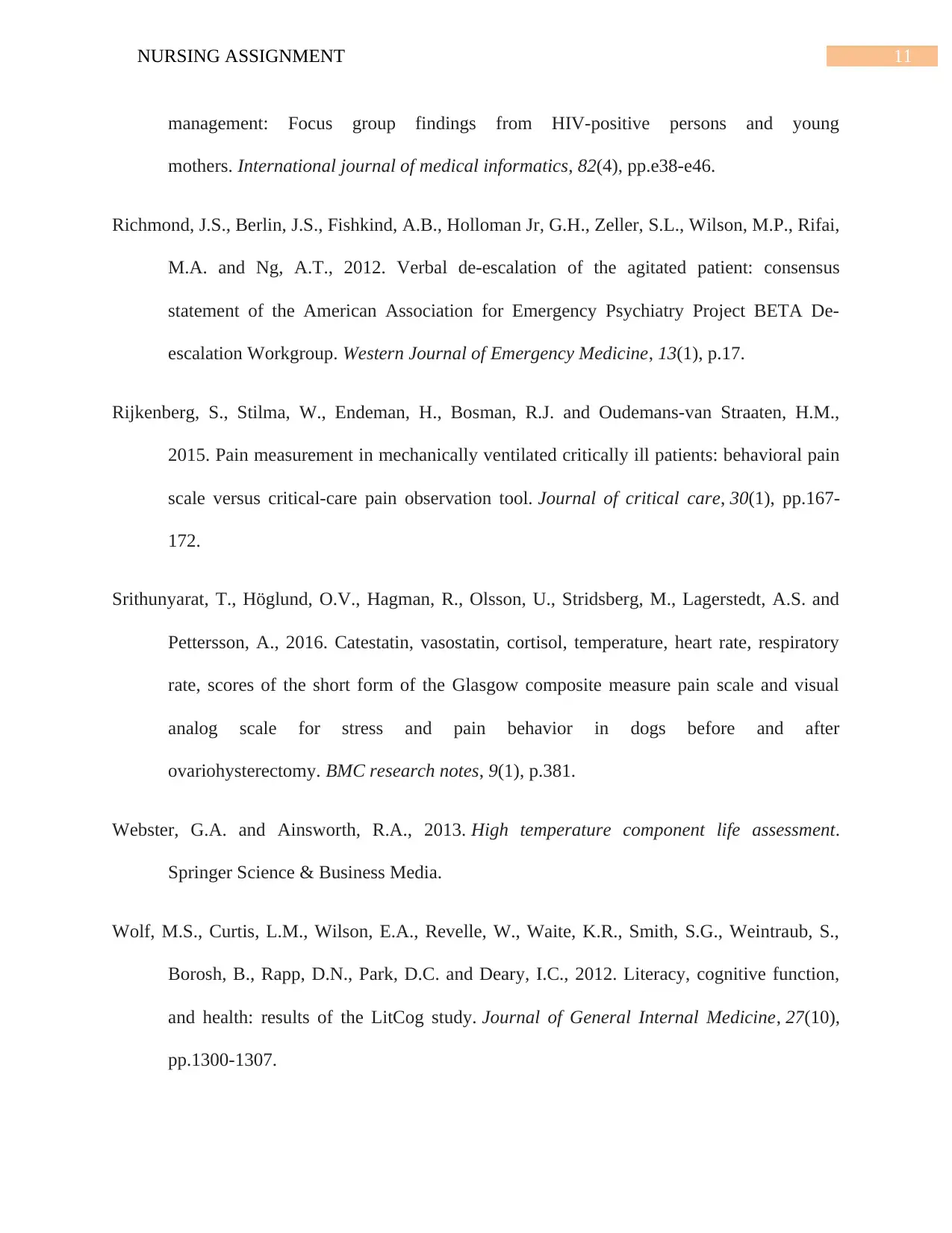
11NURSING ASSIGNMENT
management: Focus group findings from HIV-positive persons and young
mothers. International journal of medical informatics, 82(4), pp.e38-e46.
Richmond, J.S., Berlin, J.S., Fishkind, A.B., Holloman Jr, G.H., Zeller, S.L., Wilson, M.P., Rifai,
M.A. and Ng, A.T., 2012. Verbal de-escalation of the agitated patient: consensus
statement of the American Association for Emergency Psychiatry Project BETA De-
escalation Workgroup. Western Journal of Emergency Medicine, 13(1), p.17.
Rijkenberg, S., Stilma, W., Endeman, H., Bosman, R.J. and Oudemans-van Straaten, H.M.,
2015. Pain measurement in mechanically ventilated critically ill patients: behavioral pain
scale versus critical-care pain observation tool. Journal of critical care, 30(1), pp.167-
172.
Srithunyarat, T., Höglund, O.V., Hagman, R., Olsson, U., Stridsberg, M., Lagerstedt, A.S. and
Pettersson, A., 2016. Catestatin, vasostatin, cortisol, temperature, heart rate, respiratory
rate, scores of the short form of the Glasgow composite measure pain scale and visual
analog scale for stress and pain behavior in dogs before and after
ovariohysterectomy. BMC research notes, 9(1), p.381.
Webster, G.A. and Ainsworth, R.A., 2013. High temperature component life assessment.
Springer Science & Business Media.
Wolf, M.S., Curtis, L.M., Wilson, E.A., Revelle, W., Waite, K.R., Smith, S.G., Weintraub, S.,
Borosh, B., Rapp, D.N., Park, D.C. and Deary, I.C., 2012. Literacy, cognitive function,
and health: results of the LitCog study. Journal of General Internal Medicine, 27(10),
pp.1300-1307.
management: Focus group findings from HIV-positive persons and young
mothers. International journal of medical informatics, 82(4), pp.e38-e46.
Richmond, J.S., Berlin, J.S., Fishkind, A.B., Holloman Jr, G.H., Zeller, S.L., Wilson, M.P., Rifai,
M.A. and Ng, A.T., 2012. Verbal de-escalation of the agitated patient: consensus
statement of the American Association for Emergency Psychiatry Project BETA De-
escalation Workgroup. Western Journal of Emergency Medicine, 13(1), p.17.
Rijkenberg, S., Stilma, W., Endeman, H., Bosman, R.J. and Oudemans-van Straaten, H.M.,
2015. Pain measurement in mechanically ventilated critically ill patients: behavioral pain
scale versus critical-care pain observation tool. Journal of critical care, 30(1), pp.167-
172.
Srithunyarat, T., Höglund, O.V., Hagman, R., Olsson, U., Stridsberg, M., Lagerstedt, A.S. and
Pettersson, A., 2016. Catestatin, vasostatin, cortisol, temperature, heart rate, respiratory
rate, scores of the short form of the Glasgow composite measure pain scale and visual
analog scale for stress and pain behavior in dogs before and after
ovariohysterectomy. BMC research notes, 9(1), p.381.
Webster, G.A. and Ainsworth, R.A., 2013. High temperature component life assessment.
Springer Science & Business Media.
Wolf, M.S., Curtis, L.M., Wilson, E.A., Revelle, W., Waite, K.R., Smith, S.G., Weintraub, S.,
Borosh, B., Rapp, D.N., Park, D.C. and Deary, I.C., 2012. Literacy, cognitive function,
and health: results of the LitCog study. Journal of General Internal Medicine, 27(10),
pp.1300-1307.

12NURSING ASSIGNMENT
World Health Organization, 2013. Oral health surveys: basic methods. World Health
Organization.
World Health Organization, 2013. Oral health surveys: basic methods. World Health
Organization.
1 out of 13
Related Documents
Your All-in-One AI-Powered Toolkit for Academic Success.
+13062052269
info@desklib.com
Available 24*7 on WhatsApp / Email
![[object Object]](/_next/static/media/star-bottom.7253800d.svg)
Unlock your academic potential
© 2024 | Zucol Services PVT LTD | All rights reserved.




